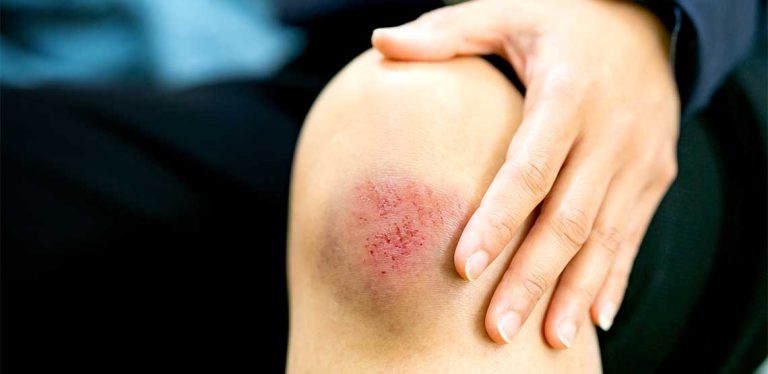How to Treat a Bruise
A bruise, known medically as a contusion, develops when tiny blood vessels get damaged and blood pools beneath the skin. The resulting skin discoloration starts black and blue and slowly fades to purple, yellow, or brown. Bruises are not typically associated with any external bleeding unless the injury also results in cuts to the skin’s surface. Bruises may form following a fall or after bumping into something. In this article, we will take a look at how to treat a bruise and when a bruise might be serious.
Are There Different Types of Bruises?
Depending upon their location on the body, bruises can be classified into these groups:
- Subcutaneous bruises: those that develop just beneath the surface of the skin.
- Intramuscular bruises: occur when blood pools within a muscle.
- Periosteal bruises: commonly called bone bruises, involve microscopic injuries to a bone.
- A black eye: can result from trauma to the head or face. Excess fluids and blood pool around the eye area, causing a distinctive black ring to form.
There are also specific types of bruising, including:
- Hematoma: this is a severe bruise resulting in a large accumulation of blood beneath the skin that can cause a lump to develop. Hematomas usually occur after a traumatic injury and can develop deep within the body where they can not be seen.
- Petechiae bruises: pinpoint, red spots that look like a rash. As petechiae form as a symptom of something else, they should always be examined by your physician.
- Purpura: also called blood spots, are small purple spots caused by blood pooling beneath the skin.
- Senile purpura: bruising caused by weakened skin from aging.
What Causes a Bruise?
The majority of bruises are caused by a minor injury or trauma and resolve themselves within two weeks. They commonly result from bumping into furniture or playing sports and may also accompany a muscle strain or sprain. More severe bruising or a hematoma may occur following a traumatic event, such as a car accident or a large fall.
Specific factors can make it more likely for you to bruise, such as advanced age and certain medications, including blood thinners and corticosteroids. Certain herbal supplements, including fish oil, may also increase your risk of bruising.
In some cases, bruising can signify a serious underlying health condition, including blood cancer, a bleeding disorder, or kidney disease. Usually, this bruising will be unexplained and random. Petechiae and purpura can result from a serious condition or an infection, or a side effect of certain medications.
We should not overlook the fact that bruising can also be a symptom of abuse.
How Do You Treat a Bruise?
Bruises can be tender and unsightly, so how can you help minimize their appearance and speed up healing? While bruises are self-limiting, healing on their own within two weeks, there are certain actions that you can take to help speed things along:
1. Immediately Ice Your Injury
Applying ice to an injury as soon as possible helps minimize bleeding by reducing blood flow, thus reducing the visibility and swelling of a bruise.
2. Rest
It is important to rest the affected area after sustaining an injury to prevent further damage and limit bleeding. By elevating an injury above the heart, you can help to reduce blood flow and prevent excess swelling.
3. Use Compression
If possible, you should apply compression to the affected area using an elastic bandage. This will help to stop excess fluid accumulation, minimizing swelling and pain.
4. Apply Heat
Heat should only be applied once a bruise has already formed. By increasing blood flow, heat therapy can stimulate the healing of the affected area.
5. Eat Healing Foods
You have probably heard of the adage, "you are what you eat." But, did you know that the food you eat can also affect your body's ability to heal injuries and bruises? In particular, pineapples may help speed up the healing of your bruise by providing your body with bromelain. This natural enzyme may reduce inflammation, swelling, and pain. Eating a diet rich in vitamins C, B-12, K, and folate can also help prevent and treat bruising.
6. Arnica Ointment
A homeopathic favorite in the medicine cabinets of many, arnica ointment can bring a welcome relief from the pain and swelling associated with your bruise. Arnica ointment can be applied directly to your bruise up to a few times per day.
How Do You Know When a Bruise is Serious?
Most bruises can be easily managed at home, using simple remedies to improve any discomfort. In some cases, a bruise can be a cause for concern, and you should seek medical advice from your doctor. Make an appointment if you notice any of the following:
- Your bruise has not healed within two weeks
- You suspect you have broken a bone
- Your bruise keeps reappearing
- Your bruise is unexplained and random
- You have accompanying pain that is not improving
Remember, you know your body best. If you are concerned about your bruising at all, you should make an appointment with your physician.
